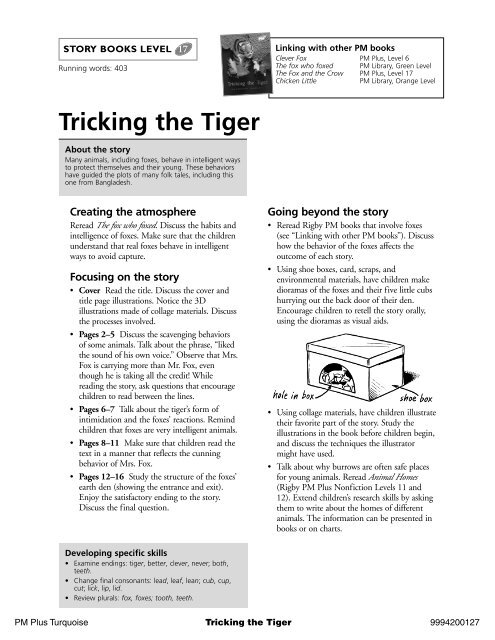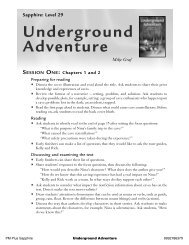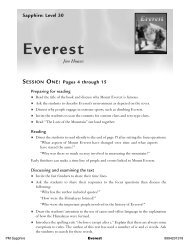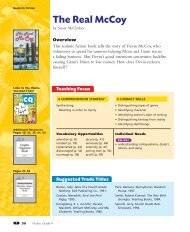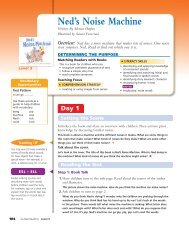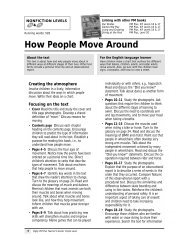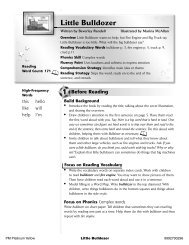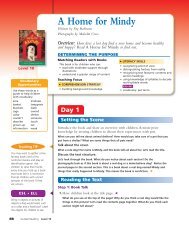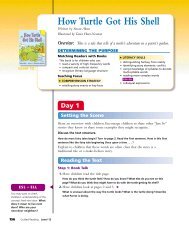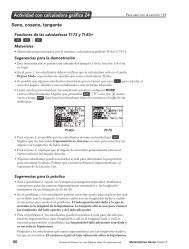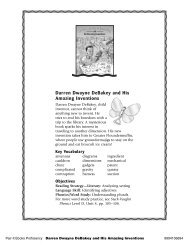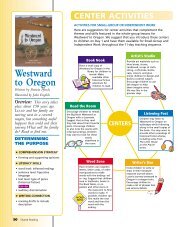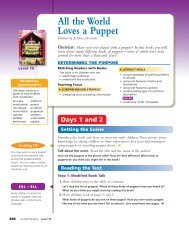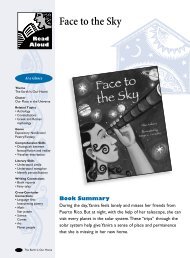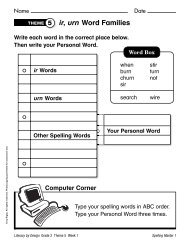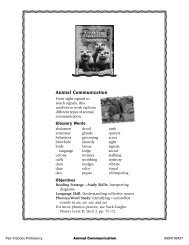Tricking the Tiger (PM Resources) Product Category - Rigby
Tricking the Tiger (PM Resources) Product Category - Rigby
Tricking the Tiger (PM Resources) Product Category - Rigby
Create successful ePaper yourself
Turn your PDF publications into a flip-book with our unique Google optimized e-Paper software.
STORY BOOKS LEVEL 17<br />
Running words: 403<br />
<strong>Tricking</strong> <strong>the</strong> <strong>Tiger</strong><br />
About <strong>the</strong> story<br />
Many animals, including foxes, behave in intelligent ways<br />
to protect <strong>the</strong>mselves and <strong>the</strong>ir young. These behaviors<br />
have guided <strong>the</strong> plots of many folk tales, including this<br />
one from Bangladesh.<br />
Creating <strong>the</strong> atmosphere<br />
Reread The fox who foxed. Discuss <strong>the</strong> habits and<br />
intelligence of foxes. Make sure that <strong>the</strong> children<br />
understand that real foxes behave in intelligent<br />
ways to avoid capture.<br />
Focusing on <strong>the</strong> story<br />
• Cover Read <strong>the</strong> title. Discuss <strong>the</strong> cover and<br />
title page illustrations. Notice <strong>the</strong> 3D<br />
illustrations made of collage materials. Discuss<br />
<strong>the</strong> processes involved.<br />
• Pages 2–5 Discuss <strong>the</strong> scavenging behaviors<br />
of some animals. Talk about <strong>the</strong> phrase, “liked<br />
<strong>the</strong> sound of his own voice.” Observe that Mrs.<br />
Fox is carrying more than Mr. Fox, even<br />
though he is taking all <strong>the</strong> credit! While<br />
reading <strong>the</strong> story, ask questions that encourage<br />
children to read between <strong>the</strong> lines.<br />
• Pages 6–7 Talk about <strong>the</strong> tiger’s form of<br />
intimidation and <strong>the</strong> foxes’ reactions. Remind<br />
children that foxes are very intelligent animals.<br />
• Pages 8–11 Make sure that children read <strong>the</strong><br />
text in a manner that reflects <strong>the</strong> cunning<br />
behavior of Mrs. Fox.<br />
• Pages 12–16 Study <strong>the</strong> structure of <strong>the</strong> foxes’<br />
earth den (showing <strong>the</strong> entrance and exit).<br />
Enjoy <strong>the</strong> satisfactory ending to <strong>the</strong> story.<br />
Discuss <strong>the</strong> final question.<br />
Developing specific skills<br />
• Examine endings: tiger, better, clever, never; both,<br />
teeth.<br />
• Change final consonants: lead, leaf, lean; cub, cup,<br />
cut; lick, lip, lid.<br />
• Review plurals: fox, foxes; tooth, teeth.<br />
Linking with o<strong>the</strong>r <strong>PM</strong> books<br />
Clever Fox <strong>PM</strong> Plus, Level 6<br />
The fox who foxed <strong>PM</strong> Library, Green Level<br />
The Fox and <strong>the</strong> Crow <strong>PM</strong> Plus, Level 17<br />
Chicken Little <strong>PM</strong> Library, Orange Level<br />
For <strong>the</strong> English language learner<br />
Select stopping points in <strong>the</strong> text where pictures<br />
match those on <strong>the</strong> BLM. Elicit details that children<br />
can write/draw on a Story Sequence Chart. Children<br />
can draw and tell about different animal homes.<br />
Going beyond <strong>the</strong> story<br />
• Reread <strong>Rigby</strong> <strong>PM</strong> books that involve foxes<br />
(see “Linking with o<strong>the</strong>r <strong>PM</strong> books”). Discuss<br />
how <strong>the</strong> behavior of <strong>the</strong> foxes affects <strong>the</strong><br />
outcome of each story.<br />
• Using shoe boxes, card, scraps, and<br />
environmental materials, have children make<br />
dioramas of <strong>the</strong> foxes and <strong>the</strong>ir five little cubs<br />
hurrying out <strong>the</strong> back door of <strong>the</strong>ir den.<br />
Encourage children to retell <strong>the</strong> story orally,<br />
using <strong>the</strong> dioramas as visual aids.<br />
• Using collage materials, have children illustrate<br />
<strong>the</strong>ir favorite part of <strong>the</strong> story. Study <strong>the</strong><br />
illustrations in <strong>the</strong> book before children begin,<br />
and discuss <strong>the</strong> techniques <strong>the</strong> illustrator<br />
might have used.<br />
• Talk about why burrows are often safe places<br />
for young animals. Reread Animal Homes<br />
(<strong>Rigby</strong> <strong>PM</strong> Plus Nonfiction Levels 11 and<br />
12). Extend children’s research skills by asking<br />
<strong>the</strong>m to write about <strong>the</strong> homes of different<br />
animals. The information can be presented in<br />
books or on charts.<br />
Using <strong>the</strong> blackline master<br />
• Study <strong>the</strong> illustrations. Discuss <strong>the</strong> sequence of<br />
events <strong>the</strong>y describe.<br />
• Ask children to write a sentence about each<br />
illustration.<br />
• Remind <strong>the</strong>m to review <strong>the</strong>ir texts for information.<br />
<strong>PM</strong> Plus Turquoise <strong>Tricking</strong> <strong>the</strong> <strong>Tiger</strong> 9994200127
<strong>Tricking</strong> <strong>the</strong> <strong>Tiger</strong><br />
<strong>PM</strong> Plus Turquoise<br />
F/P: J<br />
DRA: 18<br />
9994200127<br />
<strong>Tricking</strong> <strong>the</strong> <strong>Tiger</strong><br />
<strong>PM</strong> Plus Turquoise<br />
F/P: J<br />
DRA: 18<br />
9994200127<br />
<strong>Tricking</strong> <strong>the</strong> <strong>Tiger</strong><br />
<strong>PM</strong> Plus Turquoise<br />
F/P: J<br />
DRA: 18<br />
9994200127<br />
<strong>Tricking</strong> <strong>the</strong> <strong>Tiger</strong><br />
<strong>PM</strong> Plus Turquoise<br />
F/P: J<br />
DRA: 18<br />
9994200127


